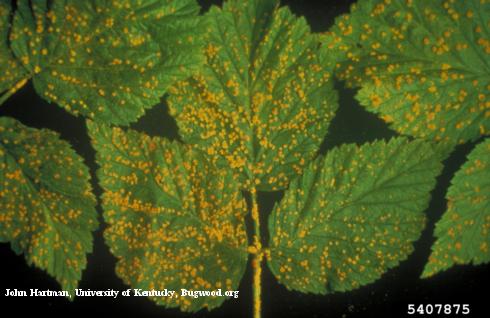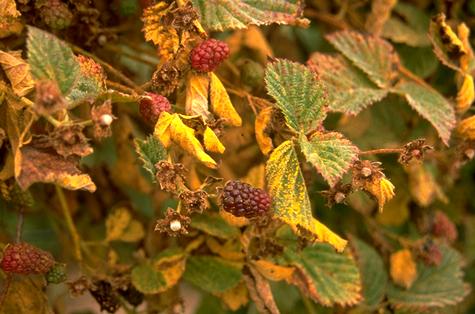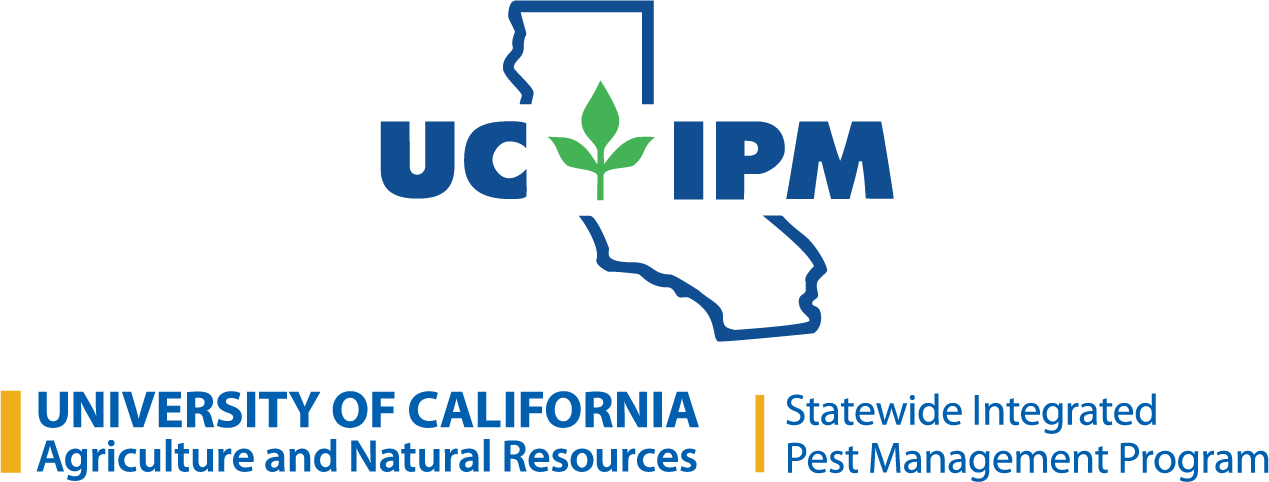Of the major caneberry crops, the yellow rust fungus infects only red raspberry.
Identification
Yellow spots develop on the upper surface of infected leaves during spring. Spots initially are very small, orange to yellow, and slightly raised bumps (spermagonia, photograph by Peter R. Bristow). Around these spots develop larger, yellowish orange pustules (aecia) commonly on raspberry leaves near the ground. The appearance of aecia on the top of leaves early in the growing season generally distinguishes yellow rust from late leaf rust, Pucciniastrum americanum, which infects red and purple raspberries.
In June and July, orange to yellow pustules (uredinia) appear on the underside of infected leaves. These structures later darken to become black teliospores that are an overwintering stage of the fungus.
Note that cane and leaf rust, late leaf rust, and orange rust also infect caneberries. These diseases can produce symptoms similar to those of yellow rust, but the season of appearance and which caneberry types are affected can help to distinguish the particular rust present. Expert examination of spores may be required to confidently distinguish which fungal pathogen is causing the rust.

Licensed under a Creative Commons Attribution-Noncommercial 3.0 License

Licensed under a Creative Commons Attribution-ShareAlike 2.0 Generic License
Life Cycle
The yellow rust fungus overwinters as teliospores on bark and any leaves remaining on floricanes (fruiting canes). Infected floricanes are the source of inoculum that infects emerging leaves and primocanes (vegetative canes) in the spring. The pathogen is not systemic, meaning it does not spread internally through the plant. It spreads by spores that are blown by the wind or splashed by overhead irrigation or rain.
Damage
Leaves severely affected by yellow rust can dry out, die, and prematurely drop. If plants are severely affected, fruit yield may be reduced. If leaves on fruiting laterals are severely infected early in the summer, fruit on the infected canes commonly dies before it matures. However, a light to moderate abundance of yellow rust infections does not affect raspberry fruit yield.

Solutions
Grow raspberries where they will receive full sun. Plant them on a raised berm or mound of soil to improve air circulation around the plants. Remove any wild caneberries near those grown for fruit because they can be alternative hosts from which the pathogen can spread.
Control weeds to improve air circulation and reduce humidity around plants. Any method of pruning and trellising that improves air circulation around caneberries helps to reduce yellow rust. The dry conditions in a macrotunnel (hoop house covered with clear plastic) greatly limit yellow rust if the tunnels are constructed before environmental conditions favor rust infections.
After harvest, cultivate to bury debris or dispose of it away from caneberries. Remove fruiting canes after harvest. Complete removal of floricanes and the first flush of primocane helps to control this disease because it removes most sources of pathogen inoculum, but it's difficult to know in advance whether this method is warranted for rust control. Stripping leaves from primocanes in the fall will also reduce overwintering inoculum.
If the fungus was abundant the previous growing season, spraying Bordeaux mixture or another copper fungicide may be warranted during the delayed dormant season, which is once buds appear and swell before they open. Alternatively or in addition, a fixed copper fungicide or myclobutanil can be sprayed during the first bloom.
References
Adapted from Raspberry (Rubus spp.)-Yellow Rust, Pacific Northwest Plant Disease Management Handbook and Pest Management Guidelines: Caneberries, University of California Statewide Integrated Pest Management Program (UC IPM).
